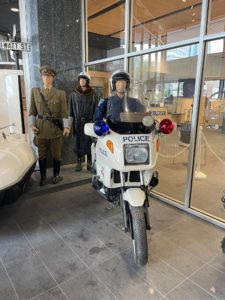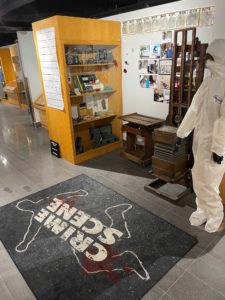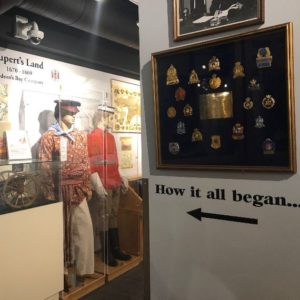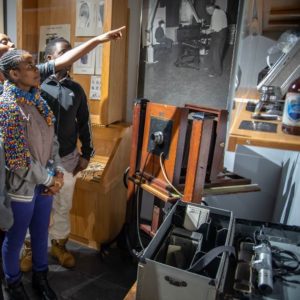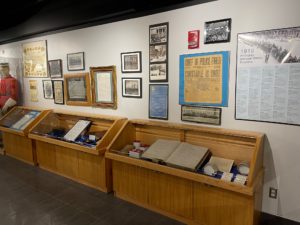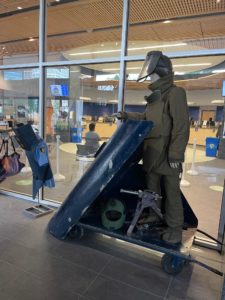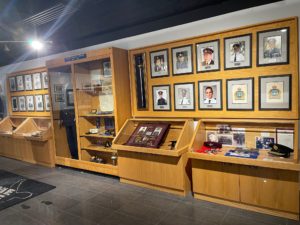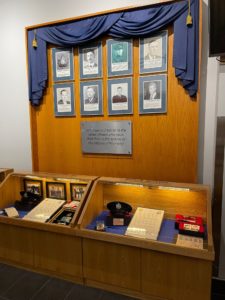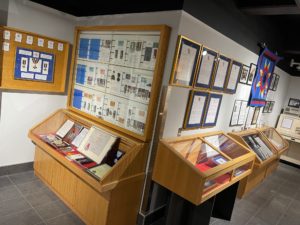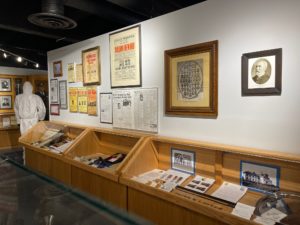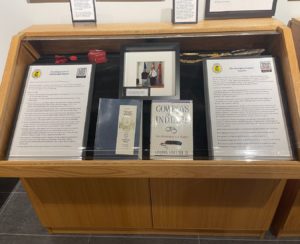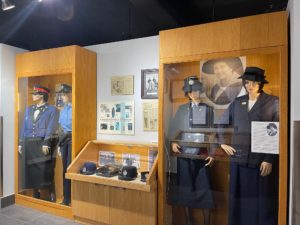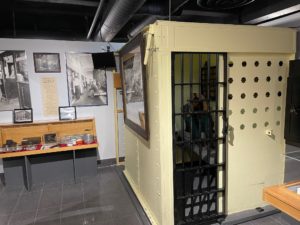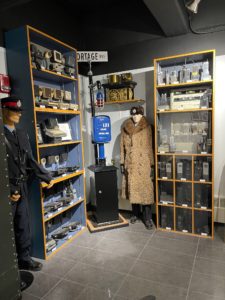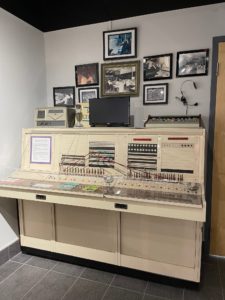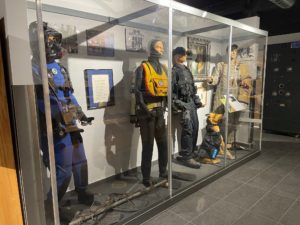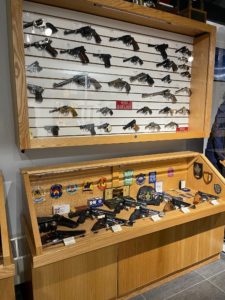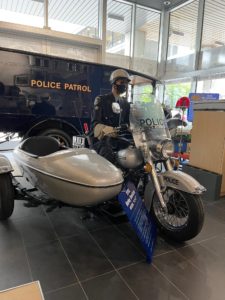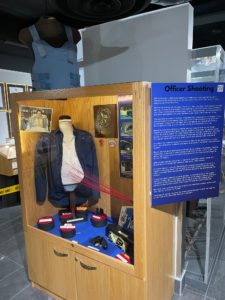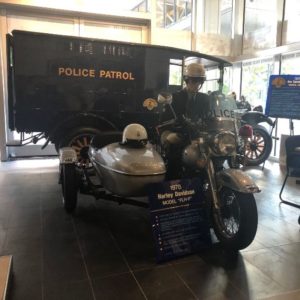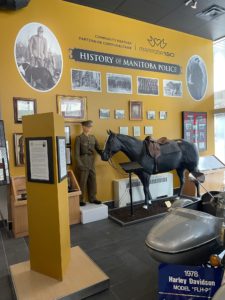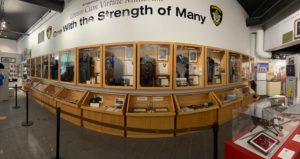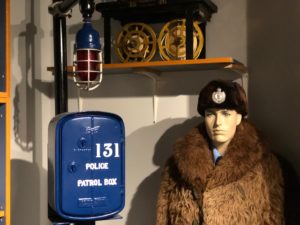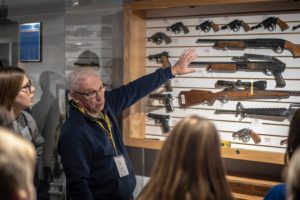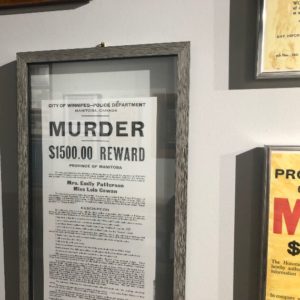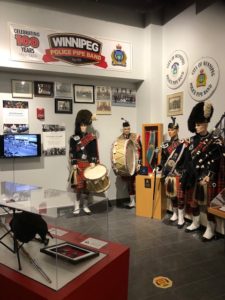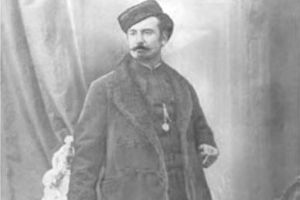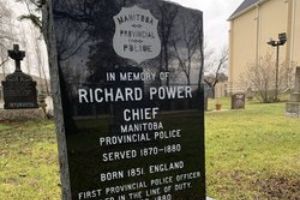Exhibits
The Winnipeg Police Museum displays artifacts relating to the history of the Winnipeg Police Force from it’s beginning in 1874 to present.
Displays include early equipment such as handcuffs, clubs and firearms, early police identification tools, including camera, fingerprint cards and arrest photos aka “mug shots”, and equipment worn by past specialty units.
The Museum also display information of some of Winnipeg’s most prolific criminals, historical events, and numerous vehicles.
We welcome visitors to take selfies throughout the museum, including at our mugshot station, inside an original 1911 jail cell and as a passenger in our 1925 REO Police Patrol otherwise called the “Paddy Wagon”.
In honor of Indigenous History Month 2021 we are virtually sharing our Indigenous display online.
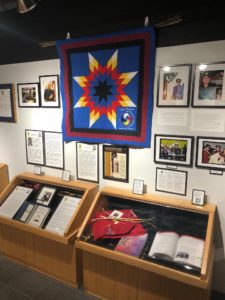
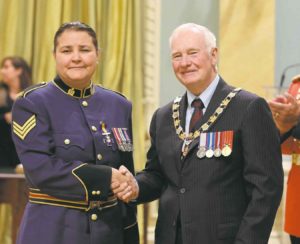

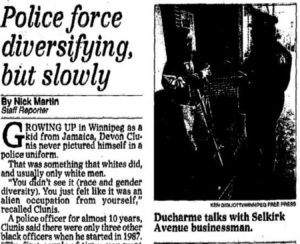
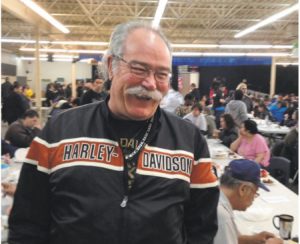
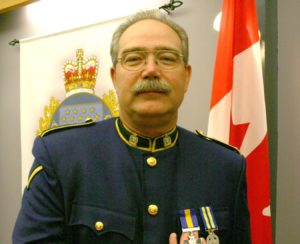
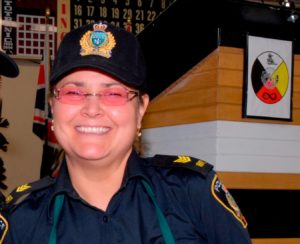

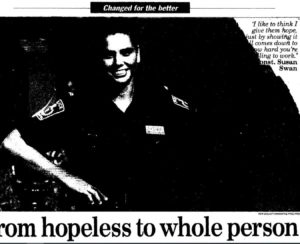
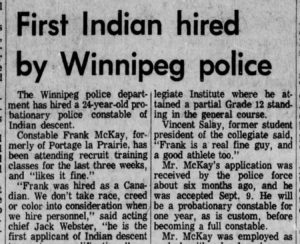
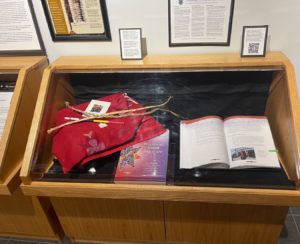
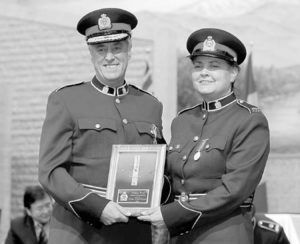
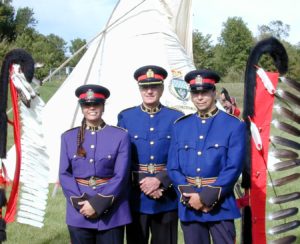
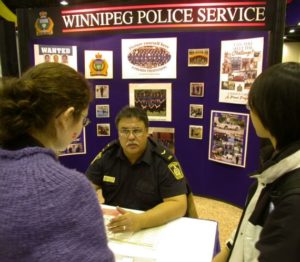
Willie and Rick met in recruit class in July 1976. Willie was a Metis male from St. Laurent, Manitoba and Rick, a Ukrainian male who grew up in Winnipeg’s Point Douglas area. Together they teamed up to help build relationships between Winnipeg’s officers and the city’s indigenous community.
One of their greatest accomplishments was introducing the Winnipeg Police’s North End Spring Feast in 1996. The feast was born from the idea that warriors of a tribe would throw feasts for the people they protected. The feast continues and now welcomes over 700 people every spring.
In 1990 they were instrumental in starting The Heat, a Winnipeg Police hockey team that toured the province playing games and raising money for community charities.
In 1999 they both enrolled in Ojibway with grade 9 students to learn more of the language and the culture.
In 2000, after being nominated by the Indian and Metis Friendship Centre, they were among the first recipients of Canada’s Minister of Justice National Youth Justice Policing Award for their innovative work in dealing with inner-city youth. They were referred to as pioneers of restorative justice after coming up with a way of holding youth accountable in a way that involved the victim and the community.
And in June 2003, Constable Ducharme helped found the first aboriginal Lions Club at the Turtle Island Recreation Centre and became its first president. The club focused on youth ages 6 – 16, supporting them in sport.
Along the way, the dedicated officers were honored to earn the spirit names Big Kind Hearted Bear (Willie), and White Wolf (Rick).
Susan was taken away from her indigenous mother at the age of two and placed with a local white family in the 1960s, taking on a new last name. She dropped out of school at age 16, was a single mother by age 18, abused alcohol and was involved in abusive relationships. Filled with hurt and hate she fought to overcome her past with a goal of reclaiming her roots (on Dog Creek Reserve) and helping other women.
Susan joined the Winnipeg Police Service in 1987 to become the first known indigenous female officer on the Service. In 1992 she changed her last name back to one she was born with. She went on to launched a street proofing program that aimed to assist rural indigenous children attending city schools and to become a community relations officer.
In 1993, Susan helped organize a three-day aboriginal youth conference which included workshops, presentations, and traditional circle dances.
In 2006, Susan was presented with the YMCA-YWCA’s Winnipeg Foundation’s Women of Distinction Award for community volunteerism.
Edith was born in Grand Rapids Manitoba and is the child of a residential school survivor. Growing up she was impacted by the intergenerational impacts of residential schools. Despite this, she was the only indigenous student to graduate from the Grand Rapids school in 1990. She made the move to Winnipeg, continued her education, and started a career with the Winnipeg Police Service in 1994.
Through her many years of dedicated service as a member of the Winnipeg Police Service (WPS), Turner has continuously striven to strengthen the relationships between the service and the indigenous community. She has shared her skills with officers locally, nationally and internationally.
In 2011 Edith was awarded the Manitoba Excellence in Law Enforcement Award.
In 2012 she received the Queen Elizabeth II Diamond Jubilee Medal, created to honour Her Majesty for her service to this country and the significant contributions and achievements by Canadians.
In 2015, Edith received one of Canada’s highest honours, the Order of Merit of the Police Forces, a fellowship of honour based on the highest qualities of citizenship, service to Canada, to the police community and humanity at large.
In 2016 Edith received the Blue Line Police Leadership Award to recognize her outstanding commitment both to the people of Winnipeg and the entire Province of Manitoba. She was also awarded the International Association of Women in Policing Leadership Award
Franklin (Frank) McKay was Winnipeg’s first known Indigenous police officer. A member of the Dakota Nation, he was born in Griswold, Manitoba in 1944. He grew up on the Oak River Reserve, (now Sioux Valley First Nation), located west of Brandon, Manitoba on the banks of the Assiniboine River. Frank’s mother attended the Indian Residential School run by the United Church in Portage la Prairie from the time she was 5 years old until she was 18.
Frank went to the Sioux Valley elementary school run by Indian Affairs and attended high school at the Portage Collegiate Institute. He lived at the Portage Indian Student Residence, the same facility his mother had lived in for thirteen years. Dakota was his first language and he was taught to speak English at school.
Frank was one of the earlier students who helped develop the integration program in the City of Portage la Prairie on an academic and community level. He was highly involved in athletics, leading his high school hockey team and league in scoring; skip in the provincial high school curling bonspiel, and represented his school in the zone track meets in the 200- and 400-yard dashes. In addition, Frank was elected President of the Student Council in his final year in residence. It was during high school Frank decided to become a police officer. Watching the interactions with the RCMP he came to appreciate that many in his community did not understand the law, and the RCMP did not understand their community.
After graduating, Frank went to Winnipeg and took Business Administration at Success Business College. He applied to the Winnipeg Police in the fall of 1967. He “would be a great asset to himself and his people, and future Indian boys across Canada,” wrote the Administrator of the Portage Indian Student Residence. This sentiment was echoed by the Indian and Metis Friendship Centre which stated that “hiring a person of Indian origin as a police constable will have much significance to the Indian people in the City of Winnipeg”.
Frank was hired by Chief George Blow and started on September 9, 1968, in A Division (downtown). Frank was part of Recruit Class #69 and graduated in December 1968. He has a fond memory of his instructors and classmates. Of his
police responsibilities he recalls being assigned to do traffic duty in the middle of Portage and Main, and the stares he would receive from motorists unaccustomed to seeing an Indigenous officer in uniform. He also remembered going to calls where the white victims or complainants only wanted to talk with his white partner. On the other hand, however, the Indigenous community would usually come and talk with him and not his partner. For personal reasons, Frank resigned from the Winnipeg Police on May 9, 1971.
Frank went on to join the Manitoba Indian Brotherhood (the forerunner to the Assembly of Manitoba First Nations) from 1971 to 1974, was elected Chief of the Sioux Valley First Nation in 1974, and became the first Chief of Police of the Dakota Ojibway Tribal Council Police Department in 1977 leading 10 indigenous police officers. He remained Police Chief until 1983 and returned briefly in 1986 and would shortly appear before the Aboriginal Justice Inquiry, commissioned in 1988, to explain the DOTC and its policing operations in Manitoba. Frank subsequently appeared before the Royal Commission on Aboriginal Peoples in 1990 to further speak about policing First Nations communities and their primary objectives to reduce crime; reduce the number and the cost to the taxpayers of prison terms by First Nations people; improve the police services received by First Nations community members; attract and retain suitable persons as police officers, and to concentrate on proactive policing as opposed to reactive policing.
In 1992 Frank had helped establish the First Nations Chiefs of Police Association (FNCPA) and became its first President in January 1993. He held the position for two years and was Vice-President for another two.
Unfortunately, in November of 1993, the DOTC Police ceased operations due to a lack of funding commitment from the Province of Manitoba. In February 1995, the new Dakota Ojibway Police Service (DOPS) resumed full-time policing services to six DOTC First Nation communities in Manitoba; Frank continued as Chief. In 2003 Frank retired from DOPS at the age of 60, although he continued to work in the justice system as a “court communicator” for the DOTC Justice Committee and as a member of the National Parole Board.
Although Frank was the first Indigenous officer hired by the Winnipeg Police, a founding member and the first Chief of Police of the DOTC/DOPS police department, and a founding member and inaugural President of the First Nations Chiefs of Police Association, he was never recognized for his police and community service.
On November 21, 2019, Frank was recognized in front of his family and peers by Winnipeg Police Chief Danny Smyth and Attorney General Cliff Cullen with the Manitoba Law Enforcement Award for Excellence.
An Eagle Staff is a symbol of an Indigenous nation’s identity and principles. Each Eagle Staff is one-of-a-kind to the people who created it, to the people to whom it is given, and to the time and place where it was made. It is a sacred symbol that is held in high esteem and used for ceremonial purposes.
The first Eagle Staff to be carried by a member of the Winnipeg Police took place in a simple ceremony on September 20, 2002, at the St. Norbert Foundation. The event was attended by elders, leaders from the community, and members of the Winnipeg Police Service including Chief Jack Ewatski. An Eagle Staff completed and assembled by Indigenous Constable Ken Anderson under the direction of elders Art Shofly and Luke Arcquette, was blessed. While this was an important step toward building a stronger relationship with the indigenous community it was not an Eagle Staff created for and transferred to the Service by the Indigenous community.
A formal presentation of a new Eagle Staff to the Winnipeg Police Service took place during a Transference Ceremony at the Manito Ahbee Festival’s Pow Wow on May 19, 2019. Chief Danny Smyth was honoured and humbled to accept the Eagle Staff from Regional Chief Kevin Hart who was accompanied by Manitoba Keewatinowi Okimakanak (MKO) Grand Chief Garrison Settee and Long Plain First Nations Chief Dennis Meeches. Elder Joseph Meconse began the process of gifting the Eagle Staff to the Winnipeg Police in 2018, reaching out to Chief Smyth and members of the Service’s Indigenous Partnership Section to honour and protect present and future members of the Service and those that have been killed, injured or passed. The Eagle Staff reflects the respect the Indigenous community has for the hard work and caring members of the Service provide to the community, and at the same time honours the Indigenous community the police are sworn to protect.
The Eagle Staff was included in the Grand Entry and Eagle Feather Ceremony for the first sitting of the Supreme Court of Canada outside of Ottawa on September 26, 2019, when they heard two cases at the Winnipeg courthouse.
On October 11, 2019, the Eagle Staff was introduced into the graduation ceremony for Recruit Class #162 at the Winnipeg Convention Centre. It marked the first significant change to the ceremony since 1999 when the Winnipeg Police Colours were introduced during the graduation of Recruit Class #128. Including the Eagle Staff recognizes and pays tribute to the Indigenous community which lived, and lives, in the area we call Winnipeg today and who work within the ranks of the Winnipeg Police Service.
Below is a brief overview of events. To read more, follow the link at the end.
John Joseph Harper, a member of the Wasagamack Indian Band, was executive director of the Island Lake Tribal Council. He and his wife Lois had three children. At the time of his death, he was 37 years old.
March 9, 1998
- Shortly after midnight, three youths stole a white Dodge Aries from the parking lot of the Westbrook Hotel.
- Shortly after 2 a.m. Mr. Harper left the Westbrook Hotel and began walking home alone.
- Shortly after 2 a.m. Constables Robert Cross and Kathryn Hodgins observed a vehicle matching the description of the stolen car and gave chase in the Weston Area of Winnipeg while broadcasting details of the pursuit.
- The stolen vehicle was eventually driven into a snowbank at Alexander Avenue and Winks Street and abandoned by two youths who ran from the vehicle.
- Constable Cross exited the cruise car near this intersection and began to search the area for the youths while Constable Hodgins remained at the scene.
- Constable Cross caught up to one youth, placed him under arrest, and took him to the cruiser car. A description of the outstanding suspect was broadcasted.
- Several assisting officers observed a second suspect in the area and gave chase on foot and by car. The suspect was located and arrested in the 2000 block of Gallagher Avenue. This information was broadcast to other members.
- At about 2:37 a.m., while officers were still searching, Constable Cross had left his cruiser car to assisted with the search. Following the broadcast of the suspect being arrested, Constable Cross was returning to his car when he came across Mr. Harper on Logan Avenue, adjacent to Stanley Park.
- After asking for identification and Mr. Harper refusing, a physical confrontation took place during which Mr. Harper was shot once, in the chest. Officers applied first aid while waiting for an ambulance. Mr. Harper died on route to the hospital.
- Acting Inspector Ken Dawson was called out to oversee the investigation.
- Read More
The Aboriginal Justice Inquiry was established in 1988 in response to two specific incidents: the 1987 trial of two men for the 1971 murder of Helen Betty Osborne, and the 1988 shooting death of J.J. Harper following an encounter with a Winnipeg police officer. These two events raised serious questions as to whether the justice system was failing Aboriginal people.
The AJI was mandated to:
Investigate, report and make recommendations to the Minister of Justice on the relationship between the administration of justice and aboriginal peoples of Manitoba, guided by but not limited to the terms of reference set out in the Schedule. (AJI, Volume I, page 3)
That Schedule established a very broad scope for the Inquiry that included “all components of the justice system, that is, policing, courts, and correctional services.” (AJI, Volume I, page 3)
The Commission was to consider whether and the extent to which aboriginal and non-aboriginal persons are treated differently by the justice system and whether there are specific adverse effects, including possible systemic discrimination against aboriginal people, in the justice system. The commission is to consider how the justice system now operates and whether there are alternative methods of dealing with aboriginal persons involved with the law. (AJI, Volume I, page 3)
The AJI held over 123 days of hearings, received over 1200 presentations and exhibits, travelled more than 18,000 kilometres, and generated 21,000 pages of transcripts. Its final report, released in 1991, filled two volumes and contained 296 recommendations.
Some of the recommendations in the aboriginal justice inquiry report included:
❚ The adoption of aboriginal community-based policing in aboriginal areas
❚ A significant strengthening of employment equity programs
❚ A significant expansion of the availability and quality of crosscultural training
❚ The development of aboriginal police commissions to support the rapid recruitment, training and effective support of aboriginal police forces
Featured Exhibit
History of Manitoba Police
The year 2020 not only marked the Province of Manitoba’s 150th anniversary, it also marked the 150th anniversary of the establishment of the Manitoba Provincial Police. In celebration of Manitoba 150 a new display was developed. The display focuses on three policemen – Louise de Plainville, Percy Rose, and Charles Constantine. You will find artifacts dating back to the beginning of policing in the province, original letters, photos and stories.
In addition, the Winnipeg Police Museum’s board of directors vice president, John Burchill, has authored a book – Pioneer Policemen, The History of the Manitoba Provincial Police, Volume 1, 1870 – 1920.
Based on the book – Pioneer Policemen – This History of the Manitoba Provincial Police, Volume 1, 1870 – 1920, this video features Percy Rose, who worked for the Manitoba Provincial Police in The Pas, Manitoba from 1917 – 1932.
Visit the museum to view the display, read more great stories and see our collection of atrifacts
Other Exhibits
